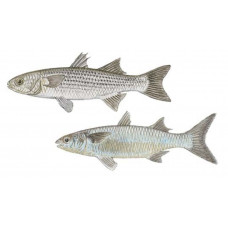Latin name
Mugil cephalus, Mugil curema
Other names
Striped mullet, white mullet, flathead grey mullet, flathead mullet, striped mullet, black mullet, bully mullet, common mullet, grey mullet, sea mullet
Identification
The striped mullet (Mugil cephalus) has a bluish-gray or green coloration along the back, turning to silver on the sides and white below. It is also known as the black mullet, or fathead, and has indistinct horizontal black stripes, or streaks, on its flanks. The fins are lightly covered with scales at the base. The nose is blunt, and the mouth is small. The second dorsal fin begins behind the anal fin. It is similar to the smaller fan-tailed mullet (M. gyrans) and the white mullet (M. curema), which have a black blotch at the base of the pectoral fins that is absent in the striped mullet. The eyes have fat eyelids extending to the pupils. Above the base of the pectoral fin, there is an elongated paddle (axillary scales). The scales on the head begin in front of the front nostrils.
Distribution
The striped mullet is a cosmopolitan in all warm seas of the world, and is the only member of the mullet family found off the Pacific coast of the United States. The fan-tailed mullet is found in the western Atlantic Ocean near Bermuda and from Florida and the northern Gulf of Mexico to Brazil. The white mullet occurs in the western Atlantic Ocean in Bermuda and from Massachusetts south to Brazil, including the Gulf of Mexico, and in the eastern Pacific Ocean from the Gulf of California, Mexico, to Iquique, Chile.
Habitat
A gregarious coastal marine fish. Young fish are often found in estuaries and the middle reaches of rivers, as well as in desalinated lakes with a connection to the sea. It is the object of breeding and rearing in many countries.
Size
Striped mullet can reach a length of 3 feet and weigh up to 12 pounds, the largest specimens have been caught in aquariums. Specimens up to 3 pounds are found in the wild, but most striped mullets weigh closer to a pound. The fan-tailed mullet is small and usually weighs less than a pound. The age limit of the lobster is probably about 16 to 18 years old. Single-aged females are always larger than males. Males mature in their third year and females mature in their fourth year.
Life history and Behavior
Mullet is a schooling fish that lives in coastal areas. Many species have the unusual habit of jumping out of the water for no apparent reason. Adult striped mullet migrate to the sea in large flocks to spawn. The fan-tailed mullet spawns in coastal or inland waters in spring and summer. White mullet spawn near the shore, while juveniles migrate to estuaries and along beaches.
Food and feeding habits
Larvae feed on zooplankton, but after a month after hatching gradually switch to the typical diet of adult fish - organic detritus, fouling, benthic crustaceans, worms. They stop feeding during migrations (spring, spawning, and autumn). They eat poorly in warm winters and completely stop eating in cold winters. Mullet collect silt from the bottom and strain out plant and animal material through their sieve-like gill shells and pharyngeal teeth.
Reproduction
During spawning, it keeps in flocks of several fish (one female and 3-7 males). The spawning season in the Black Sea lasts from late May-June until late August. Spawning apparently takes place at a small distance from the shore. Fertility is 3-13 million eggs. Eggs are pelagic, spherical, about 0.7 mm in diameter, with a fat drop 0.28 mm in diameter. Depending on the temperature, development lasts from 1.5 to 5 days. Larvae hatch at 2.4 mm in length. They are 1-3 cm long in July and 2-6 cm in September. By spring, the yearlings grow to 5.6-5.7 cm, sometimes up to 10 cm.
| Classification | |
| Phylum | Chordata |
| Class | Actinopterygii |
| Squad | Mugiliformes |
| Family | Mugilidae |
| Genus | Mugil |
| Species | M. cephalus |
| Features | |
| Conservation status | Least Concern |
| Habitat | Pelagic |
| Life span, years | 18 |
| Maximum body weight, kg | 12 |
| Maximum length, cm | 100 |
| Sailing speed, m/s | No information |
| Threat to people | Edible |
| Way of eating | Bentophage |
Mullet
Tags: Mullet






